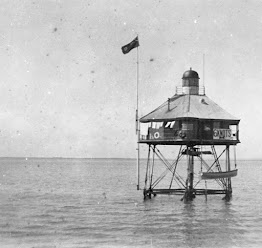The following article appeared in The Telegraph, 27 April 1928 and gives a descriptive account of the journey from Brisbane to Bribie to collect a sick man and convey him to a hospital in Brisbane.
A Hazardous Trip. The Storm Flayed Bay.
At 4.30 p.m. on April 18 [1928] a full south-east gale was raging in Moreton Bay with very fierce cloud bursts of blinding rain.
At this time, Mr James Crouch, of Byron
Street, Bulimba, proprietor and skipper of the passenger trading launches Radio
(65 feet) and Twilight II (48 feet 6 inches), and the 18 feet racing boats,
Queenslander III and J.C., received an urgent telephone message from Mr James
Clark, of New Farm, of pearl shell fame, and who also is a veteran in local
sailing racing, and owner-skipper of many boats for pleasure, trading and
racing.
Mr Clark had previously received a message from Toorbul, Bribie, stating that his elder brother, Steven (1), was seriously ill. Having failed to obtain transport aid from other regular sources, owing to the severity of the weather, Mr Clark approached Mr Crouch (2), and the latter immediately undertook the hazardous journey within an hour of receiving the message. With his two sons, Bert and Cecil, and other assistance, they provisioned the ship, and at 5.30 p.m., with an ambulance bearer and invalid stretcher and equipment aboard the Radio, left for Bribie. Radio is a comparatively new launch that has served the sailing clubs as a flagship, and she had not previously been tested in heavy weather in open waters. She is purely a pleasure boat for passenger service, and has a very large awning, her beam being 14 feet and draft 4 ft. 6in., with high bulwarks all round, and watertight raised decks covering the fore and aft cabins and the engine room, the latter being amidships. The power equipment is a 45 h.p. Palmer marine engine, which was the sole propelling power, so that any engine trouble meant danger in the sever circumstances.
The Radio cut out ten miles an hour, but it
was dark when she entered the heavy seas at the Pile Light House, whence a
course was set due north by the compass. So black did the night become that
those on board could not even see each other at arm’s length.The Pile Light House
on a calm day
SLQ 39669
When the wide expanse of the Bay was
reached mountainous seas were encountered, and there was great excitement among
those aboard the Radio. The boat was severely tossed about. Neither a beacon
light nor a land mark was discernible; all those aboard knew was that they were
proceeding north. The compass told them that.
The storm raged and the Radio raced on
the billows at the rate of 20 miles an hour until the wave pace beat her and
let her down gently in the trough for the next sea to take and toss her like a
cork. So formidable did the strain become at this point that the engine had to
be put into neutral and the launch travelled under storm pressure only for
nearly half an hour. Heavy steering was necessary to hold the course. At 9.30
p.m. the Bribie leading lights were picked up and Radio was berthed at Mr Clark’s
Toorbul jetty at 10 p.m. to the great relief and comfort of the party. Mr Clark’s
chief concern was for the comfort and safety of his sick brother, and he was
anxious to get him aboard to enter on the return journey without delay. But the
weather was against this, and it was not until 4.30 the next morning that the
patient was brought aboard and made snug on the main cabin deck. The launch
proved her mettle to the fullest degree during the two and a-half hours’ battle
against big head seas and a howling gale. She rolled decks awash repeatedly and
the seas lashed from stem to stern, which she would plunge from billow to
billow and frequently have her head pointing heavenward.
The severity of the sea smashing on the
hull tore the metal sheathing from the under-bow. The trip was completed at Mr
Thos. Welsby’s waterside residence at New Farm, after a four-hours journey from
Bribie and the patient was conveyed by ambulance to Holyrood private hospital,
where, despite all the efforts to save his life, he died.
NOTES
(1) Stephen Clark (1850-1928), a master mariner, who lived at White Patch in his latter years. He was the elder brother of James Clark (1857-1933) of "pearl shell fame" as mentioned above.
(2) James Crouch (1879-1966) and his sons Bert (b. 1902) and Cecil (b. 1906).
REFERENCE
Sailing. A Hazardous Trip. The Storm Flayed Bay. By "Seabreeze".
The Telegraph Fri 27 Apr 1928, p. 2 http://nla.gov.au/nla.news-article179328000
Image - Pile Light in Moreton Bay, ca 1909.
State Library of Queensland, negative 39669

No comments:
Post a Comment